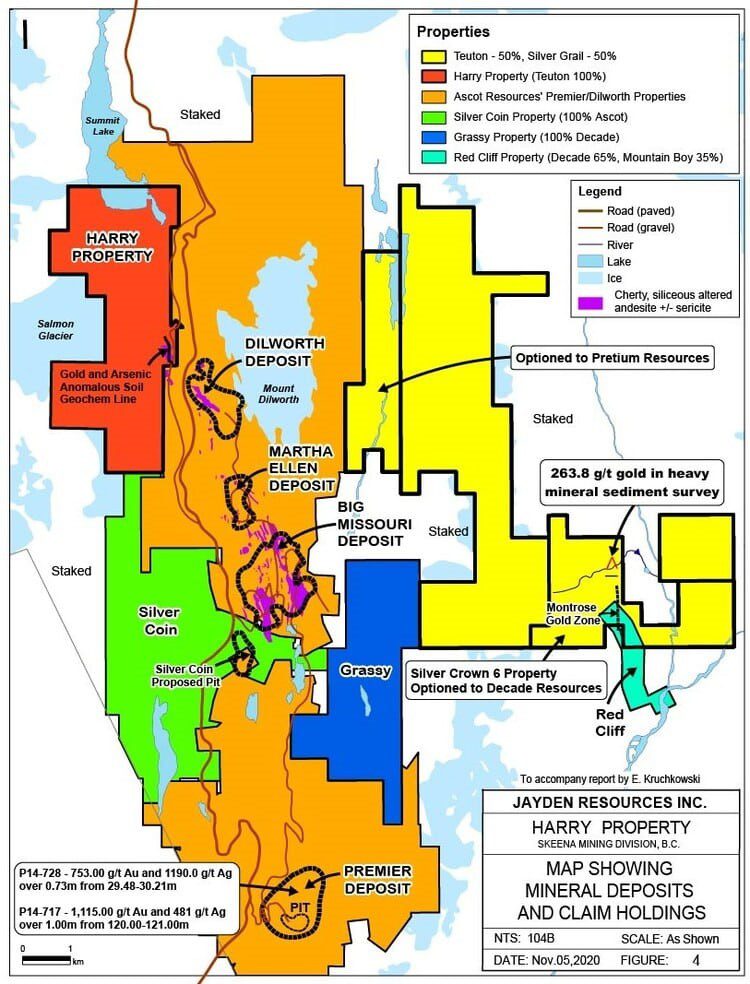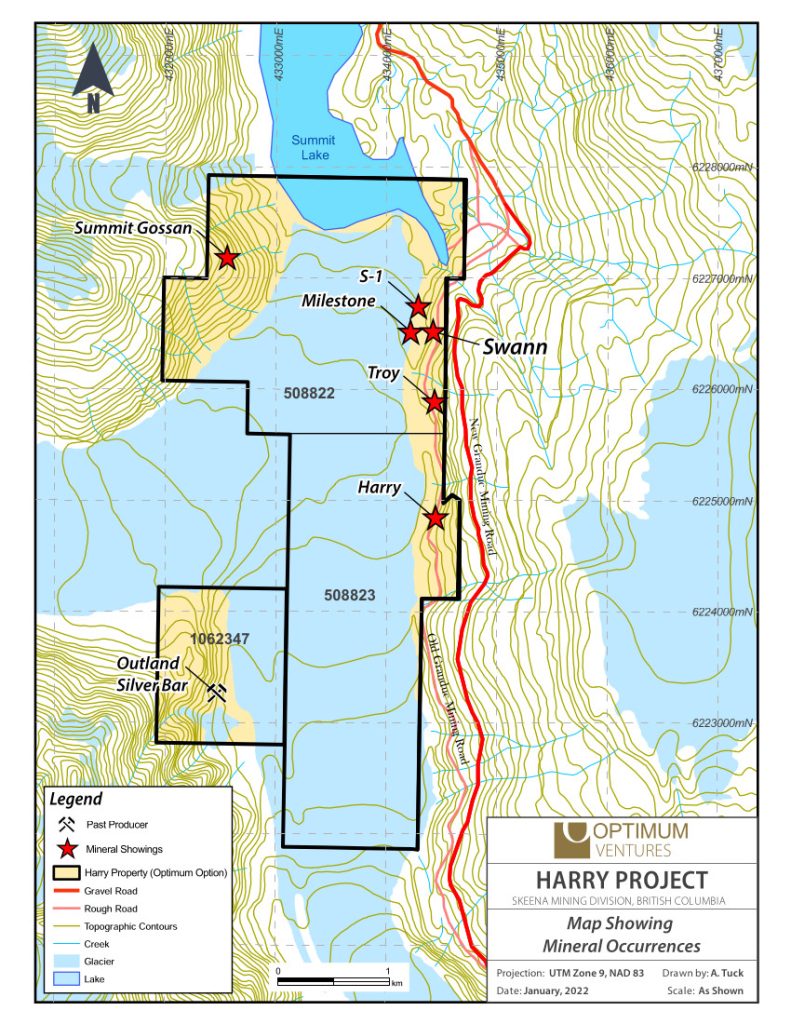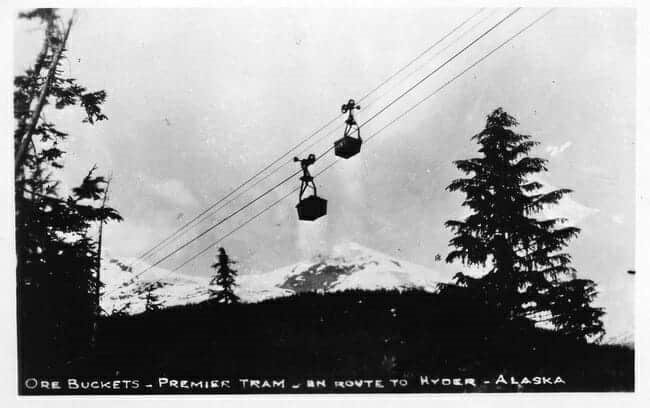THE GOLDEN TRIANGLE
HISTORY OF THE REGION
Alexander ‘Buck’ Choquette triggered the first gold rush in the region when he struck gold at the confluence of the Stikine and Anuk Rivers. The year was 1861.
Once hailed as the largest gold mine on the continent, the past-producing Premier Gold Mine began its production cycle in 1918, hitting its peak during the Great Depression. It produced approx. 2 million ounces of gold and 45 million ounces of silver during its 34-year run.
Discovered in 1964, the Snip Gold Mine produced approx. one million ounces of high-grade gold between 1991 and 1999.
In 1988, Stikine Resources and partner Calpine hit one of the richest holes in Canadian mining history at Eskay Creek – 27.2 g/t gold and 30.2 g/t silver over 208 meters.
After an intense bidding war for control of the deposit, the Eskay Creek Mine would go on to produce 3.3 million ounces of gold at 45 g/t Au and 160 million ounces of silver at 2224 g/t Ag during its ~14-year run. The mine also generated significant lead and zinc credits.
All three of these past-producing mines still hold significant resources in their subsurface stratum. Currently being explored/developed by Skeena Resources, Eskay Creek holds 5.28 AuEq ounces of primarily open-pit material at the high end of the (open-pit) grade range. Using US $1,550 gold and US $22.00 silver price inputs, a 2021 PFS demonstrates an after-tax NPV(5%) of C$1.4B and an IRR of 56%.
CURRENT PRODUCERS IN THE REGION
The Golden Triangle is host to one of the largest hydrothermal systems in the world – the Sulphurets Hydrothermal System.
The southern half of the Sulphurets Hydrothermal System is host to 185 million ounces of gold, 739 million ounces of silver, and 50 billion pounds copper in all resource categories. This represents one of the most significant concentrations of metal value on the planet.
The southern half hosts the Brucejack Mine (Pretium Resources) and the KSM Project (Seabridge Gold).
BRUCEJACK MINE
Brucejack Mine, operated by Pretium Resources, began producing in July of 2017. It is ranked one of the highest-grade mines in the world. Measured and Indicated resources at Brucejack currently stand at 7.2 million ounces of gold at 10 g/t and 48.8 million ounces of silver at 67.5 g/t.
RED CHRIS MINE
The Red Chris Mine (Newcrest Mining and Imperial Metals), which began producing in 2015, produced 88.3 million pounds of copper and 73,787 ounces of gold in 2020. A resource estimate dated March 31, 2021, showed approximately 1.2 billion tonnes of mineralized material containing roughly 14.9 million ounces of gold and 4.3 million tonnes of copper.
KSM PROJECT
KSM is one of the largest undeveloped gold projects in the world – current Measured & Indicated resources stand at 76.4 million ounces of gold and > 17.1 billion pounds of copper. Inferred resources = 65.9 million ounces of gold plus >33.2 billion pounds of copper. There are also 728 million ounces of silver across all resource categories and substantial molybdenum credits.
The Treaty Creek Project (Tudor Gold, Teuton Resources, and American Creek) lies along the northern extension of the Sulphurets Hydrothermal System. Measured and Indicated resources at Treaty Creek = 17 million oz gold and 93 million oz silver. Inferred resources = 7 million oz gold and 41 million oz silver.
Other large undeveloped projects in the Golden Triangle include Shaft Creek (5.8M ozs of Au and 5.6M lbs of Cu) and Galore Creek (8M ozs of Au and 9.8B lbs of Cu).
PREMIER PROJECTS
Immediately adjacent to the Harry Project, Ascot Resources is looking to re-start operations at its Premier Gold Project.
Premier’s Indicated AuEq resource, across multiple deposits, currently stands at 1,099,000 ounces @ 8.25 g/t. Inferred AuEq resources = 1,213,000 ounces @ 7.45 g/t.
According to the Ascot website: “At ~8 g/t AuEq, the highest-grade undeveloped underground project with reserves in Canada not owned by a producer.”
In April 2020, Ascot released a feasibility study outlining a high-return project with a base case after-tax NPV5% of $341M, an IRR of 51%, and an after-tax payback period of 1.8 years. The study outlined an 8-year mine life producing an annual average of 151k ounces AuEq at AISC of US$769/oz gold.
Ascot began consolidating the immediate area around its Premier Gold Project in early 2019, taking out IDM Mining for its Red Mountain Project (782,600 ozs of Au and 2,155,800 ozs of Ag M&I).
Ascot will be following developments next door at Optimum’s Harry Project closely.

FURTHER SIGNIFICANT INVESTMENT IN THE REGION
A robust pipeline of development projects is the key to a producer’s long-term survival.
In mid-2019, Australian-based Newcrest Mining paid $804 million for a majority stake in Imperial Metals’ Red Chris Mine located in the northern portion of the Golden Triangle. In early 2021, Newcrest announced its intention to invest another C$135M in the project.
In the same area, in Q1 of 2021, Newmont acquired GT Gold’s Tatogga Project, a copper-gold porphyry deposit, for $393M.
More recently, on Nov 9th, 2021, Newcrest took out Pretium Resources in a deal valued at $3.5 billion.
Newcrest’s total investment in the Golden Triangle is now close to $4.5 billion.
The pace of M&A in the Golden Triangle appears to be accelerating. Companies with significant discoveries on their books will be watched closely by these producing companies.
Well-heeled investors have also made significant investments in the region. Canadian billionaire Eric Sprott has taken a large position in the Treaty Creek deposit via Tudor Gold, Teuton Resources, and American Creek equity.
Franco-Nevada recently made a significant investment in Skeena’s Eskay Creek Project.


